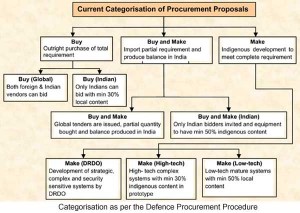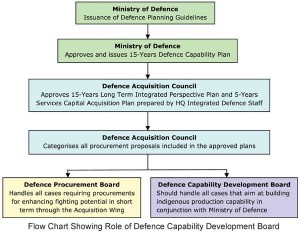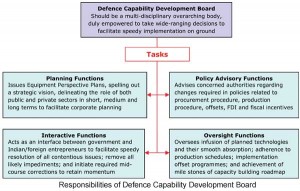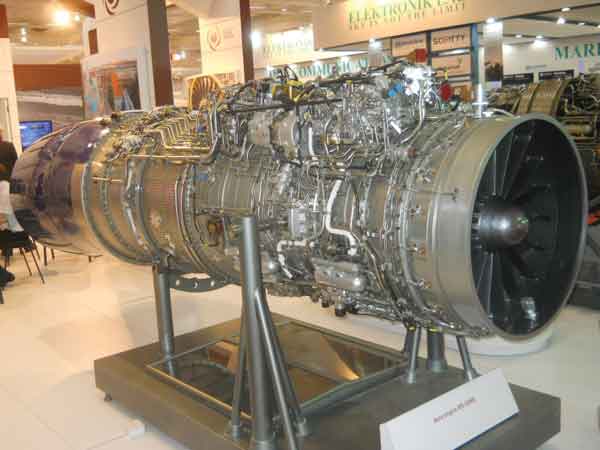Two major defence production related developments that took place nearly a decade ago need to be recalled here at the outset. One, having realised the limitations of the public sector, the Government of India constituted six Joint Task Forces in collaboration with the Confederation of Indian Industry in 1998 to promote defence-industry partnership. Integration of the private sector was considered essential to achieve the often repeated objective of procuring 70 per cent of India’s defence requirements from indigenous sources by 2010. Consequently, defence production was opened to the private sector in January 2002, allowing 100 percent private equity with 26 percent Foreign Direct Investment (FDI).
Two, as a follow up of the recommendations made by the Group of Ministers in the wake of the Kargil War, a dedicated defence procurement organisation were set up in 2001 and a comprehensive defence procurement procedure (DPP-2002) was promulgated with the stated aim of promoting self reliance in defence production. There was euphoria in the air and India appeared to be heading in the right direction. Those were exciting times.
…India should have a technology centric FDI policy with inherent flexibility. It could be 26 percent for low-tech products, 51 to 74 percent for matured systems and 75 to 100 percent for cutting edge technologies.
However, all hopes have been belied. The last decade has been a chronicle of tall claims, missed opportunities and inability to translate policies into implementable programmes. The current regime has been a total failure. The enormity of failure can be gauged from three visible facts. One, imports have climbed to close to 75 percent rather than dropping to the targeted 30 percent. Two, India has not been able to produce a single defence system with cutting-edge technology. While every critical item is being imported, India continues to be happy producing doors and windows for foreign aviation majors. Three, defence exports (from India’s much vaunted conglomerate of Ordnance Factories) fell from a paltry Rs 41.07 crores in 2008-09 to a laughable Rs 12.28 crores in 2009-10. It is a reflection of the nature and quality of items being produced indigenously.
As a result of the above mentioned failures, not a single objective concerning defence production and procurement has been achieved. Consequently, induction of new equipment has not materialised at the required pace. In his address to a seminar in New Delhi on 15 December 2010, Defence Minister Antony acknowledged, “Despite our best intentions and earmarking huge budgets and allocating money, the modernisation efforts have not borne the desired results.” There cannot be a more candid admission of failure.
Despite periodic reviews of the procurement procedure and repeated reiteration of the objectives, self-reliance will remain a pipe dream unless bold and ingenious decisions are taken to correct existing deficiencies. As quantities required by the Indian armed forces cannot provide necessary economies of scale, development of a robust and vibrant export market is absolutely inescapable. Additionally, in the present day environment, a country’s defence industry cannot thrive in a standalone mode in indigenous isolation. It has to be a part of the international arms production and trade regime.
Manufacturing Hub for the Global Factory
All major defence companies are system integrators. High costs and complexities of modern day warfare ordnance have forced major arms manufacturers to spread their various manufacturing, commercial and management functions over a number of sites in different countries. They follow the emerging and evolutionary concept of ‘Global Factory’ whose contours and shapes are yet to acquire an absolute form. Locations are chosen on the basis of relative advantages they offer for specific functions. Host country’s policies and incentives also influence selection. Additionally, ease of integration with a worldwide network becomes the clinching factor in the selection of a location.
European Aeronautic Defence and Space Company (EADS) with its integrated headquarters at Paris employs over 110,000 persons at more than 70 production sites, predominantly in Germany, France, Great Britain and Spain. BAe Systems has 90,000 employees on its rolls at 25 locations in Great Britain and 18 locations elsewhere. Safran, which is fast emerging as a giant on the world defence equipment scene after the merger of Snecma and Sagem, has its head office in Paris. It employs over 56,000 people and has industrial, design and commercial operations in more than 30 countries.
…on 15 December 2010, Defence Minister Antony acknowledged, “Despite our best intentions and earmarking huge budgets and allocating money, the modernisation efforts have not borne the desired results.” There cannot be a more candid admission of failure.
Geo-economically distributed and spatially dispersed facilities have come to stay. To be a central part of the arms ‘Global Factory’, India has to strive to become a global manufacturing hub for defence equipment. It must project itself as an ideal destination and convince the foreign manufacturers of the advantages accruing to them as compared to competing suitors. For that, India has to revamp the regime and make major policy and structural changes.
Attracting FDI
FDI is a need based concept. The host nation needs funds and technology for its accelerated growth while a foreign investor is guided purely by economic considerations. A long term commitment through FDI sets in motion a chain reaction wherein FDI upgrades existing technology which, in turn, attracts more FDI with higher technology. Any nation that covets FDI in defence has to tailor its policies to make them irresistible.
The current policy has been a total failure. Its provisions are highly dissuasive and irrational – a foreign investor is expected to invest his resources in a venture where he has no significant control, strict capacity/product constraints, no purchase guarantee, no open access to other markets (including exports) and where preference may be accorded to the local public sector.
To make India a manufacturing hub, FDI has to flow in. Therefore, India has to put its act together by evolving an investor-friendly policy, streamlining procedures and projecting an image of an ideal FDI destination for defence industry. All help should be provided to ensure economic viability of enterprises. Import of dual use technology should be encouraged for economies of scale. It benefits other segments of the economy as well.
 Therefore, India should have a technology centric FDI policy with inherent flexibility. It could be 26 percent for low-tech products, 51 to 74 percent for matured systems and 75 to 100 percent for cutting edge technologies. Even the Ministry of Commerce had proposed total elimination of FDI ceiling to ‘encourage greater cooperation and information sharing between international defence manufacturers and Indian defence companies’. With a view to facilitate economies of scale, export provisions must be relaxed, albeit keeping national interests in mind. This in turn will reduce India’s cost of procurement as well as earn foreign exchange. Similarly, enough flexibility must be provided to joint ventures as regards capacity and diversification options to cater for market dynamics. No preference should be given to the public sector and Ministry of Defence (MoD) must provide a level playing field to all producers. That will go a long way in enhancing the credibility of the policy.
Therefore, India should have a technology centric FDI policy with inherent flexibility. It could be 26 percent for low-tech products, 51 to 74 percent for matured systems and 75 to 100 percent for cutting edge technologies. Even the Ministry of Commerce had proposed total elimination of FDI ceiling to ‘encourage greater cooperation and information sharing between international defence manufacturers and Indian defence companies’. With a view to facilitate economies of scale, export provisions must be relaxed, albeit keeping national interests in mind. This in turn will reduce India’s cost of procurement as well as earn foreign exchange. Similarly, enough flexibility must be provided to joint ventures as regards capacity and diversification options to cater for market dynamics. No preference should be given to the public sector and Ministry of Defence (MoD) must provide a level playing field to all producers. That will go a long way in enhancing the credibility of the policy.
Modification of Defence Procurement Procedure
First of all, DPP needs to be simplified. Starting with three categories in 2002, we have seven categories of procurement proposals at present. Every revision of the procedure has created more categories, thereby compounding the confusion. See Figure.
After assigning developmental cases for ‘strategic, complex and security sensitive systems’ to DRDO, classification of all other cases should be restricted to three broad categories – ‘Buy (Global)’, ‘Buy (Indian)’ and ‘Buy and Make’. See Figure. ‘Buy and Make’ should be applied to cases where initial purchase is made from a foreign producer and the balance quantity is produced in India under transfer of technology. Recipient of technology should be the most suited Indian industrial entity and not necessarily the public sector, as at present. ‘Buy (Indian)’ with minimum 50 percent local content should be the most preferred route for the majority of procurements. This shall force foreign vendors to partner Indian firms to produce equipment in India.
Furthermore, the procedure must reward high-tech performance. Presently, all systems that meet laid down parameters are considered at par and the lowest bidder is awarded the contract, superior technology and performance notwithstanding. It is one of the most unfair and dissuasive provisions wherein a vendor with superior product is expected to quote less than a mediocre product. In ‘Buy and Make’ cases, such a process results in India getting deprived of latest technologies as base-level products are invariably based on obsolescent technologies. As seen earlier, no country can aspire to be a manufacturing hub without regular infusion of cutting edge technologies.
Technology Infusion through Offsets
All countries try to use the leverage of offsets in consonance with their national economic priorities to fill an important technological/economic void. Countries that strive to develop indigenous industry seek technology through offsets to bridge the gap and use the acquired technology as a takeoff platform for indigenous development of more advanced technologies. More than 35 percent of all offsets worldwide relate to technology transfer. Transfer of technology is rightly called as the engine that drives offsets.
The Government has to realise that both public and private sectors are national assets and harnessing of their potential is essential if India wants to achieve self reliance…
Strangely, India does not accept technology against offsets. Despite repeated assertions of determination to achieve self reliance in defence equipment, India has left it to foreign vendors to choose offset programmes. As is to be expected, every vendor opts for offset activities that are easy to implement and entail least cost penalty, Indian needs notwithstanding.
With a view to prompt sellers to offer offsets in targeted areas, all countries allot suitable multiplier values to various offset programmes, thereby assigning differential weightage to them. Multiplier value is a factor applied to the actual value of an offset transaction to calculate the credit value earned. By adopting a graded system of multipliers, buyer nations persuade sellers to offer offsets in fields that carry higher multipliers. Sellers find the system equally useful as it provides them an opportunity to earn enhanced offset credit value. Illogically, India does not use the system of multipliers.
With the current flawed policy, offsets are not contributing to the upgradation of the indigenous technological base. India must use the leverage of offsets to obtain technologies that are considered essential for stimulating and expediting the growth of indigenous industrial competence to make India a hub. Therefore, India must amend its offset policy to make transfer of technology to be the preferred mode. It should also apply suitable multiplier values to different programmes, depending upon the criticality of the technologies involved, to obtain the needed know-how.
Integration of the Private Sector
Despite repeated assertions of the Government to integrate the private sector in defence industry, the defence procurement procedure continues to favour the public sector. Although the defence industry was opened to the private sector in 2001, there is little progress on ground. The private sector continues to be a peripheral player with the production of some low-tech items and components. A handful of India’s top companies have invested considerable resources but have been rewarded with a few small value defence contracts. Major contracts continue to flow to the public sector as hitherto fore. Private sector is on the brink of losing patience.
While the public sector possesses excellent infrastructure, manufacturing facilities and a highly experienced task force, the private sector excels in technology absorption and managerial practices, marketing skills and financial management. The Government has to realise that both public and private sectors are national assets and harnessing of their potential is essential if India wants to achieve self reliance in defence production. Instead of playing favourites, it should facilitate their mutual accommodation and aim at exploiting their respective strengths through synergetic functioning. Both the sectors should be considered equal and indispensable partners in India’s march towards developing a vibrant defence industry.
Attitudinal Changes
Indian officialdom, consisting of career bureaucrats, is known for its arrogant and pompous attitude. Being the ultimate authority to award or deny contracts, they regard businessmen as seekers of favours and treat them with scant respect. Businessmen are viewed as mere wealth seekers. Aware of the power wielded by the officials, Indian business community considers it prudent to keep them in good humour by acquiescing in an unequal equation.
All developed countries acknowledge the contribution made by entrepreneurs and honour them as creators of national wealth.
However, foreign companies find officials’ imperious behaviour to be highly unacceptable, impolite and gratuitous. It is common to hear them complain of non-acknowledgement of key communications and reluctance to grant appointments. A veteran foreign entrepreneur went to the extent of declaring that Indian bureaucracy was the single most dissuasive factor for investors. “How can one enter into a business relationship in India when one is made to feel like a lesser human being? Supercilious attitude of Indian officials is insufferable, to say the least,” he averred.
All developed countries acknowledge the contribution made by entrepreneurs and honour them as creators of national wealth. They are respected for their business acumen, technological skills and managerial excellence. Unless Indian officials change their attitude and learn to treat businessmen as indispensable and equal partners, investors will continue to be wary of doing business in India. It must be understood and accepted that generation of reasonable profit is the prime objective of all business, and there is nothing immoral about it.
Structural Changes – Need for an Overarching Authority
Creation of a manufacturing hub would entail grant of numerous licences and permission by a multitude of ministries and departments. Also, a number of policy questions would invariably crop up needing immediate decision making. Presently, there is no centralized authority empowered to handle all issues pertaining to defence industry in India. Vendors are made to run from one office to another. As is done in almost all countries, a multi-disciplinary “Defence Capability Development Board” (DCDB) must be constituted under the Commerce Minister to oversee the complete gamut of related activities. It should act as a single window interface for all entrepreneurs.
 On the basis of the Defence Planning Guidelines, the MoD prepares and approves 15-Years Defence Capability Plan. From the above plan flows 15-Years Long Term Integrated Perspective Plan (LTIPP) for the three services. It is prepared by HQ Integrated Defence Staff in consultation with Service HQ and Approved by the Defence Acquisition Council (DAC) under the Defence Minister. 5-Years Services Capital Acquisition Plan (SCAP) is extracted from LTIPP and duly approved by DAC. Both LTIPP and SCAP spell out services’ requirement of equipment in medium and long terms.Additionally, DAC categorises various procurement proposals based on the need to enhance fighting capability in short term vis-a-vis acquisition of technology to build indigenous capacities in a longer time frame. All cases pertaining to capability enhancement should flow to the Defence Procurement Board for initiating acquisition action by the Acquisition Wing. Simultaneously, cases that aim at building capacity through acquisition of technology should be passed on to DCDB. It should be for DCDB to consider various alternatives in conjunction with MoD and select the most efficient and cost-effective route. See Figure.
On the basis of the Defence Planning Guidelines, the MoD prepares and approves 15-Years Defence Capability Plan. From the above plan flows 15-Years Long Term Integrated Perspective Plan (LTIPP) for the three services. It is prepared by HQ Integrated Defence Staff in consultation with Service HQ and Approved by the Defence Acquisition Council (DAC) under the Defence Minister. 5-Years Services Capital Acquisition Plan (SCAP) is extracted from LTIPP and duly approved by DAC. Both LTIPP and SCAP spell out services’ requirement of equipment in medium and long terms.Additionally, DAC categorises various procurement proposals based on the need to enhance fighting capability in short term vis-a-vis acquisition of technology to build indigenous capacities in a longer time frame. All cases pertaining to capability enhancement should flow to the Defence Procurement Board for initiating acquisition action by the Acquisition Wing. Simultaneously, cases that aim at building capacity through acquisition of technology should be passed on to DCDB. It should be for DCDB to consider various alternatives in conjunction with MoD and select the most efficient and cost-effective route. See Figure.
DCDB should not be seen to be replacing MoD in any policy domain. Functioning of DPDB should be broadly on the lines of the Border Roads Development Board (BRDB), albeit with suitable changes. BRDB is an inter-ministerial body with a status of Department of the Government of India with administrative control under MoD while funds for the roads are provided by the Ministry of Shipping and Transport.
Production and procurement of defence equipment for modernisation of the armed forces are multifaceted processes requiring highly specialised expertise. It is not a routine governmental activity. MoD neither has the necessary expertise nor the resources (including time) to handle all such complexities. DCDB could be a facilitating mechanism to help MoD to achieve its goal of self sufficiency. DCDB should take guidance and directions from MoD and implement them on ground in a professional and concerted manner. See Figure 4 for the tasks that should be assigned to DCDB.
The Way Forward
 India must become a key player in global supply chain. For that, there has to be a fundamental change in our approach towards the defence industry. The following steps are recommended:-
India must become a key player in global supply chain. For that, there has to be a fundamental change in our approach towards the defence industry. The following steps are recommended:-
- Demand for FDI in defence has become highly competitive as a large number of suitors are chasing a few defence equipment giants. India must resort to an innovative Investment Promotion (IP) drive. IP has come to be accepted as the most indispensable factor to create a favourable image and generate interest amongst the investors to look at a location more closely. IP should encompass all activities that contribute towards making a location attractive to foreign investors.
- India should focus on technology infusion and upgradation of indigenous industrial base. Therefore, incentives should be offered as per the quality and level/depth of technology being transferred. Incentives can be both fiscal (loans, grants and tax exemptions) and non-fiscal (land allotment, infrastructural facilities and training assistance).
- Close and transparent cooperation between MoD and defence industry is a prerequisite. It should be based on mutual trust. Architecture of the hub should be such that the armed forces get assured supplies of critical equipment with best value for money. Simultaneously, investors should get fair and reasonable return on their investments with minimal risks.
- It is universally accepted that offsets make sound business sense only if the trade-off results in extraordinary economic or technological gains. Leverage of offsets must be effectively used to obtain critical technologies that industrially-advanced countries are reluctant to sell.
- A single empowered authority should be constituted to provide single window clearances and guidance to all entrepreneurs.
Defence industry comprises of all industrial undertakings engaged in the production of hardware and services for use by the defence forces. In addition to economic factors, defence industry is generally considered to be an instrument of national sovereignty and pride. Given its favourable geo-political position and technical man-power, India must strive to be a hub for global outsourcing and partner co-production of defence products as a part of multi-nation consortiums. Development of a defence industry hub will bring technology and intellectual assets, thereby imparting ‘knowledge edge’ to the indigenous industry and contributing to generation of employment opportunities and national prosperity. Without technological and commercial competitiveness, no industry can sustain itself for long in open competition. Therefore, India has to put its act together in an innovative manner.







BEML is a leading defence manufacturingfirm in India. As a government project they are emerging as countrys leading bulletproof military vehicle manufacturer in India.
Major Suman provides an excellent summary and a starting point on the matter of defense production. A caution is in order. Planning nation’s need for the cutting edge defense equipment in a rapidly changing world will require major overhaul of the way India invests in the defense equipment. FDI is one option and should be pursued vigorously. Private sector involvement in the defense production, however, must play a major role if India is to make a dent. The examples in US and Europe point the direction. Most leading producers of advance equipment in the world are privately owned with exceptions in Russia and China. The backbone is knowledge pertaining to defense technologies. This must be acquired by any means possible to leverage the developing capabilities of the indigenous sources. Universities, National and Private Labs, and research institutions nationwide must be part of the knowledge building. Regulations and government control must be cleaned up and made free of babu-raj corruptions. Here, because of past disasters, the PM office must personally oversee the transaction regime. All this is vital not only from the standpoint of national security but is a vital part of the economic development of the nation. Just look at the huge investments being made in purchasing foreign made defense equipment, which are often outdated by the time these are put to use. If most of these purchases were made in India from the Indian producers, the jobs and the rollover effect would benefit endlessly beside providing the most advance defense equipment for the nation’s security.